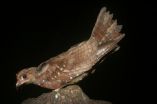(Press-News.org) A team of international scientists, including a trio from Simon Fraser University, has published the world's first ranking of evolutionary distinct birds under threat of extinction. These include a cave-dwelling bird that is so oily it can be used as a lamp and a bird that has claws on its wings and a stomach like a cow.
The research, published today in Current Biology, the shows that Indonesia, Australia and New Zealand all score high on responsibility for preserving irreplaceable species. The researchers examined nearly 10,000 bird species and identified more than 100 areas where additional protection efforts would help safeguard avian biodiversity.
"We used genetic data to identify the bird species that have the fewest relatives on the 'Tree of Life', that is, which species score highest on the 'evolutionary distinctness' index," explains SFU biologist, one of the six authors of a study that was seven years in the making.
The index was created by former SFU PhD student Dave Redding, another of the trio, and was applied to an updated version of the first global tree of birds, published in 2012 by the group in Nature.
The researchers, led by Mooers and Walter Jetz at Yale University, combined the index with data on extinction risk and maps of where every bird in the world lives. The result is a snapshot of how the entire Tree of Life of birds is distributed on the planet, and where on earth the tree is most at risk of being lost.
"Given that we cannot save all species from extinction, these distinct species are of special conservation concern, since they are truly irreplaceable - they have no close relatives that share their DNA," Mooers says.
Jeff Joy, another SFU team member, adds: "Many of these distinct species are also incredibly cool. The number-one bird is an oily cave-dweller and the number-three bird has claws on its wings and a stomach like a cow, while still another, the Abbott's Booby, breeds only on Christmas Island."
Mapping where distinct species are on the planet also gives insight into which areas and countries steward disproportionate amounts of bird evolution. The data also offer some insight into large-scale processes affecting biodiversity, Mooers says.
"We also found that if we prioritize threatened birds by their distinctness, we actually preserve very close to the maximum possible amount of evolution," says Mooers. "This means our method can identify those species we cannot afford to lose and it can be used to preserve the information content represented by all species into the future. Both are major goals for conservation biology."
The new rankings will be used in a major conservation initiative called the Edge of Existence program at the London Zoo. The zoo has already identified several species like the huge monkey-eating Philippine eagle that are at once distinct, endangered, and suffer from lack of attention.
INFORMATION:
Funding came from several sources, including NSERC, NERC, NSF, NASA, and the Yale Institute for Biospheric Studies.
Simon Fraser University is consistently ranked among Canada's top comprehensive universities and is one of the top 50 universities in the world under 50 years old. With campuses in Vancouver, Burnaby and Surrey, B.C., SFU engages actively with the community in its research and teaching, delivers almost 150 programs to more than 30,000 students, and has more than 125,000 alumni in 130 countries.
Simon Fraser University: Engaging Students. Engaging Research. Engaging Communities.
World ranking tracks evoluntionary distinctness of birds
2014-04-10
ELSE PRESS RELEASES FROM THIS DATE:
Insights into how a bird flu virus spreads could prevent pandemics
2014-04-10
The H5N1 bird flu virus has infected and killed hundreds of people, despite the fact that, at the moment, the virus can't spread easily between people. The death toll could become much worse if the virus became airborne. A study published by Cell Press April 10th in the journal Cell has revealed a minimal set of mutations allowing H5N1 to be transmitted through the air from one ferret to another. The findings will be invaluable for future surveillance programs and may provide early warning signals of the emergence of potential pandemic strains.
"By gaining fundamental ...
Genetic distinctness to guide global bird conservation
2014-04-10
In the midst of today's global extinction crisis, decisions about conservation should include prioritizing how best to preserve as much of the tree of life as possible. So say researchers who report in the Cell Press journal Current Biology on the first application of an approach to identify the most evolutionarily distinct of the world's 9,993 bird species.
At the very top of their list of the most evolutionary distinct birds is the South American oilbird, which represents almost 80 million years of evolution shared with no other bird on the planet.
"Evolutionary distinctness ...
Researchers find that influenza has an Achilles' heel
2014-04-10
Flu epidemics cause up to half a million deaths worldwide each year, and emerging strains continually threaten to spread to humans and cause even deadlier pandemics. A study published by Cell Press on April 10 in the journal Immunity reveals that a drug that inhibits a molecule called prostaglandin E2 (PGE2) increases survival rates in mice infected with a lethal dose of the H1N1 flu virus. The findings pave the way for an urgently needed therapy that is highly effective against the flu virus and potentially other viral infections.
"Drugs that specifically target PGE2 ...
Team solves decades-old mystery of how cells keep from bursting
2014-04-10
LA JOLLA, CA—April 10, 2014—A team led by scientists at The Scripps Research Institute (TSRI) has identified a long-sought protein that facilitates one of the most basic functions of cells: regulating their volume to keep from swelling excessively.
The identification of the protein, dubbed SWELL1, solves a decades-long mystery of cell biology and points to further discoveries about its roles in health and disease—including a serious immune deficiency that appears to result from its improper function.
"Knowing the identity of this protein and its gene opens up a broad ...
Lactate metabolism target halts growth in lung cancer model
2014-04-10
BOSTON – Cancer cells generate energy differently than normal cells, a characteristic that helps them to survive and metastasize. A major goal in the field of cancer metabolism is to find ways to overcome this survival advantage.
Now a research team led by investigators in the Cancer Center at Beth Israel Deaconess Medical Center (BIDMC) has found that targeting the enzyme responsible for the final step of glucose metabolism not only halts tumor growth in non-small-cell lung cancer, but actually leads to the regression of established tumors.
Importantly, the new findings, ...
Getting to the root of Parkinson's disease
2014-04-10
Working with human neurons and fruit flies, researchers at Johns Hopkins have identified and then shut down a biological process that appears to trigger a particular form of Parkinson's disease present in a large number of patients. A report on the study, in the April 10 issue of the journal Cell, could lead to new treatments for this disorder.
"Drugs such as L-dopa can, for a time, manage symptoms of Parkinson's disease, but as the disease worsens, tremors give way to immobility and, in some cases, to dementia. Even with good treatment, the disease marches on," says ...
Too much protein may kill brain cells as Parkinson's progresses
2014-04-10
Scientists may have discovered how the most common genetic cause of Parkinson's disease destroys brain cells and devastates many patients worldwide. The study was partially funded by the National Institutes of Health's National Institute of Neurological Disorders and Stroke (NINDS); the results may help scientists develop new therapies.
"This may be a major discovery for Parkinson's disease patients," said Ted Dawson, M.D., Ph.D., director of the Johns Hopkins University (JHU) Morris K. Udall Center of Excellence for Parkinson's Disease, Baltimore, MD. Dr. Dawson and ...
Researchers determine how mechanical forces affect T-cell recognition and signaling
2014-04-10
T-cells are the body's sentinels, patrolling every corner of the body in search of foreign threats such as bacteria and viruses. Receptor molecules on the T-cells identify invaders by recognizing their specific antigens, helping the T-cells discriminate attackers from the body's own cells. When they recognize a threat, the T-cells signal other parts of the immune system to confront the invader.
These T-cells use a complex process to recognize the foreign pathogens and diseased cells. In a paper published this week in the journal Cell, researchers add a new level of understanding ...
Researchers identify transcription factors distinguishing glioblastoma stem cells
2014-04-10
The activity of four transcription factors – proteins that regulate the expression of other genes – appears to distinguish the small proportion of glioblastoma cells responsible for the aggressiveness and treatment resistance of the deadly brain tumor. The findings by a team of Massachusetts General Hospital (MGH) investigators, which will be published in the April 24 issue of Cell and are receiving advance online release, support the importance of epigenetics – processes controlling whether or not genes are expressed – in cancer pathology and identify molecular circuits ...
Yale researchers search for earliest roots of psychiatric disorders
2014-04-10
Newborns whose mothers were exposed during pregnancy to any one of a variety of environmental stressors — such as trauma, illness, and alcohol or drug abuse — become susceptible to various psychiatric disorders that frequently arise later in life. However, it has been unclear how these stressors affect the cells of the developing brain prenatally and give rise to conditions such as schizophrenia, post-traumatic stress disorder, and some forms of autism and bipolar disorders.
Now, Yale University researchers have identified a single molecular mechanism in the developing ...


